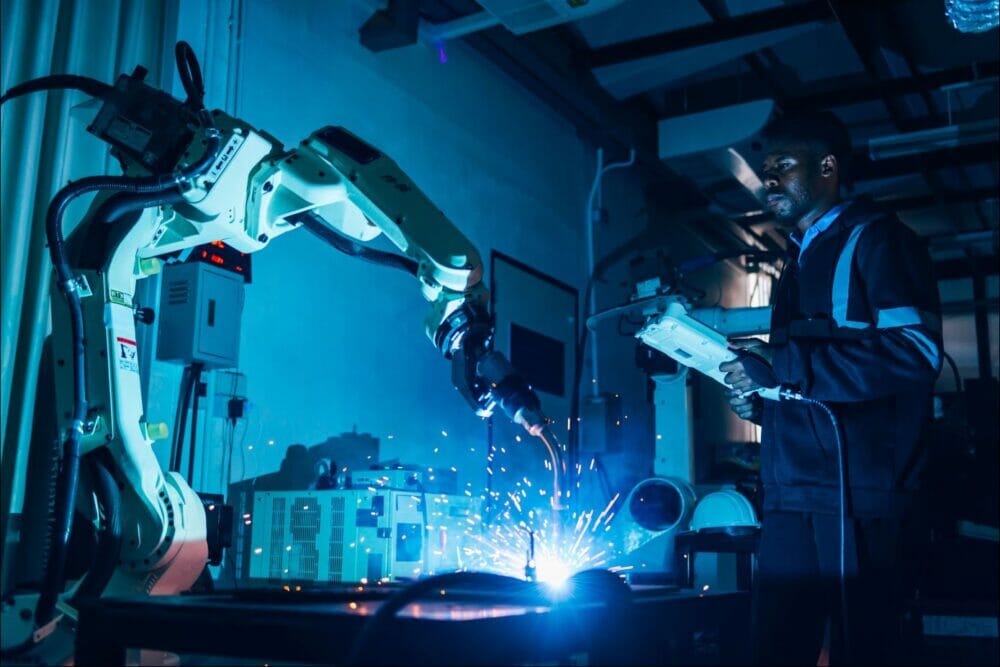By Andy Graham, Solutions Manager, SolutionsPT
Writing a piece like this can be difficult for a number of reasons, mainly because the needs of manufacturers are vastly different from business to business. That being said, there are a number of common trends we are seeing with our customers that are applicable across the entire manufacturing sector, no matter the size of the company or the output. I will be outlining what we have seen at SolutionsPT as the major trends moving forward for manufacturers but I’m also very keen to hear your thoughts.
Trend one – Return on Investment
First and foremost, the main concern among manufacturers is cost. While this is certainly not specific to only manufacturing, the cost of living crisis has impacted probably every business across the UK in some form. For manufacturers in particular, return on investment is a driving force for change and digital transformation. It has also been a driving force for how manufacturers purchase industrial software and advance in their own DX journeys.
The ‘as-a-service’ approach, common from a consumer level, is now gaining rapid ground in manufacturing, where it is changing the way companies think about CAPEX, OPEX and TCO. As consumers, it’s how many of us view media content, communicate with each other, and explore new hobbies. It may have taken a while for industry to catch up with this subscription model but now it is a great option for manufacturers who are looking to maximise their spend, no matter the size of budget.
We see these two elements as intrinsically linked, the crack down on spending is forcing manufacturers to ask the tough questions and ensure that any spend will pay back in one form or another. Traditional software licensing can be costly and lock customers to one product for a set period of time, this approach also prohibits experimentation and means manufacturers can miss out on efficiency, productivity, safety, maintenance, or energy use benefits that are well within reach. By moving industrial software purchasing to a subscription approach, manufacturers can explore the full suite of options, find what works best for them, and deploy new solutions without having to face huge, risky CAPEX investments. Subscription will absolutely be the future of industrial software purchasing, enabling manufacturers of any size to consistently explore the wide array of available benefits made possible through digital transformation, while keeping a firm grasp on the budget.
Trend two – Human transformation
At SolutionsPT we consider digital transformation to be the integration of digital technology into all areas of a business – the people, processes and technology. More specifically, the use of innovative technologies to combat any operational friction or inefficiencies. These systems are connected, accessible and enterprise-wide. The first factor on our list there is the human one, and issues like the skills gap and the ageing workforce is pushing manufacturers to capture integral ‘on-the-job’ knowledge before it is lost forever. This involves a level of human-digital transformation, using the elements associated with DX and applying them to human skills rather than data collected from a machine asset, and the benefits are two-fold.
On one end of the spectrum, the ageing workforce has spent an entire career learning vital information that keeps manufacturing facilities running. Not just knowledge about industrial assets and how to work in the sector, but knowledge that is specific to the facility they work. The information held in their heads must be passed on to the next generation workforce to ensure a smooth transition as young employees take the first step away from education and into a place of work. No matter how talented or educated a student is in their field, it will always require a level of facility specific understanding to move from theoretical to actual operations.
On the other end of the spectrum, the technology used to digitise skills and present them to the next generation workforce is almost expected in the modern world. Being able to remotely request support or see tailored content based on what’s in front of the worker would all be expected from young people who use similar technology in their everyday lives. Companies that fail to advance in digital transformation in this way may also risk missing out on new employees who choose to work at more advanced manufacturing businesses.
The onboarding process can also be streamlined with this digitisation of skills, offering further incentive for business owners to invest and create a connected workforce that can overcome any challenge, whether that is remote workers, disparate assets, or changeover of staff. While the needs of each manufacturer will differ from business to business, the need to have a digitised skills repository and worker oversight will always remain.
Trend three – Connectivity
Connectivity has been a huge talking point within manufacturing and even the wider industrial sectors for many years now. While it is easy to see the benefits of joining enterprises together there can be a hesitancy, especially from large companies, to implement Cloud connectivity and the perceived danger of having data shared in an unsecure environment. Given the increased frequency of cyber attacks on industrial settings it is a valid concern. This is one of those examples where technology is the concern, but the right technology is also the solution to secure Cloud connectivity.
Some improvements are very quick and easy to achieve through simple education, such as plugging in external USB devices or opening phishing emails. Others are more complex – manufacturing companies often have a signature-based antivirus approach. What this does is use the unique identifiable bits of code that associates with a specific malware, compared against a database of known signatures. While this is effective against known malware, it can’t defend against zero-day attacks as there is nothing in the database to compare code to. Artificial Intelligence works by teaching it what is okay to be running on the network, once it knows the parameters it will exclude anything else. AI cybersecurity only needs to be updated every six months and can effectively protect a manufacturer’s network from all malware.
In previous years, these cyber concerns hindered businesses reaching optimal levels of connectivity, now we see much less resistance from large manufacturers as connectivity is desired and an accepted part of digital transformation, leading to a multitude of benefits.
Trend four – Ecosystems
The final trend I wanted to examine for manufacturing is one that concerns ecosystems. We are quite unique at SolutionsPT in that our AVEVA solutions are completely vendor agnostic, creating a completely open system. What this allows is for us to work with a wide range of integrators and solutions providers to offer the best-in-class options which will in turn work alongside any existing systems inside a manufacturing facility. We view this as a digital transformation ecosystem, combining the very best to deliver the most value for manufacturing end users. While in previous years it is common for businesses to lock end users into their systems, whether that be an OEM or software solution, and keep customers coming back by limiting their options, there has been a huge shift across manufacturing solution providers. Now, companies are happy to be seen as experts in what they offer, and work with what previously may have been a competitor to create a combined solution. This ecosystem approach is becoming more prevalent and can even be seen in recent packaged solutions like the Schneider Electric EcoStruxure Micro Data Centre. This product is a perfect example of an ecosystem working together, combining the offering of Stratus Technologies Edge Computing platform, Schneider Electric’s environmental protection and uninterrupted power supply, and AVEVA software to create a single product that be can deployed with one purchase that is digital transformation ready.
As digital transformation partners, SolutionsPT are always at the forefront of technology within manufacturing. Always looking ahead at the changing landscape and assessing the trends that will impact our manufacturing end users for the next few years.
Contact SolutionsPT today to explore how any of the trends mentioned here can meet your business-specific needs.








